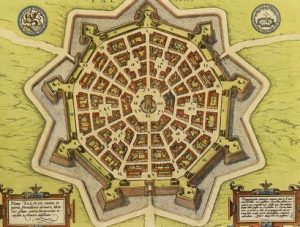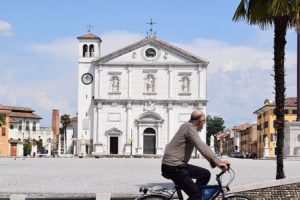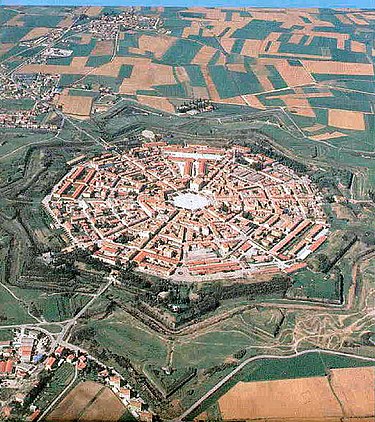Ok, Mrs L said. Here’s a place we must visit. It’s not too far away, has an outstanding and unusual nine sided shape in the landscape. The walls are more or less complete and are comparative with Lucca for accessibility. There’s an amazing nine sided piazza in the centre of the city with a shimmering white cathedral.
Oh, and there’s a bakery making artisan gluten free bread. AND a restaurant specialising in gluten free food, including pizza.
It was her chance to have her first pizza of the trip. By this time I was several pizzas, calzonis and focacias up on the deal. It was only fair that we tracked down this elderado of coeliac available goodness.
I tried to keep my cynicism at bay, having over the years trudged around various towns, in rain and extreme heat, only to be disappointed that the venue was closed for the day, closed for ever or had never existed. You can’t believe all you read on the web!
The City was Palmanova and it turned out that it is an absolute gem. It seems that it isn’t on the regular tourist trail so we were able to enjoy it untroubled by crowds.

Palmanova was built following the ideals of a utopia. It is a concentric city with the form of a star, with three nine-sided ring roads intersecting in the main military radiating streets. It was built at the end of the 16th century by the Venetian Republic which was, at the time, a major centre of trade. It is actually considered to be a fort, or citadel, because the military architect Giulio Savorgnan designed it to be a Venetian military station on the eastern frontier as protection from the Ottoman Empire.
The circular shape of Palmanova was greatly influenced by the fact that it needed to be a fort. The walls run at angles so that enemy soldiers could not approach it easily because the angles made it possible to establish overlapping fields of defensive fire.
The cathedral is located in the central square. Commissioned in 1603, the construction started later that year under Inspector Girolamo Cappello, and was completed in 1636. The identities of any architects are uncertain, but may have been Vincenzo Scamozzi and Baldassare Longhena. The cathedral was not consecrated until 1777, after the town had been included into the Archbishopric of Udine. The bell tower of the cathedral, erected in 1776, was deliberately made short because enemies attacking the city should not be able to see the cathedral from outside the city walls.
Enough of this culture. The real highlight of our visit was the gluten free content.
As we approached the bakery (Bricole di Bontar, 15, Borgo Aquileia) all looked promising. For a start it was actually there. But we were too late. All of the bread was sold. The shelves were empty. The lovely lady behind the counter was appropriately downcast in conveying the bad news. However she did hand over a packet of gf bread sticks as a small consolation.
So on we went to the restaurant. Called il melograno It was an absolute triumph. We both had superb pizzas made with the best of ingredients. The smoked cheese on mine was a particularly nice touch.


